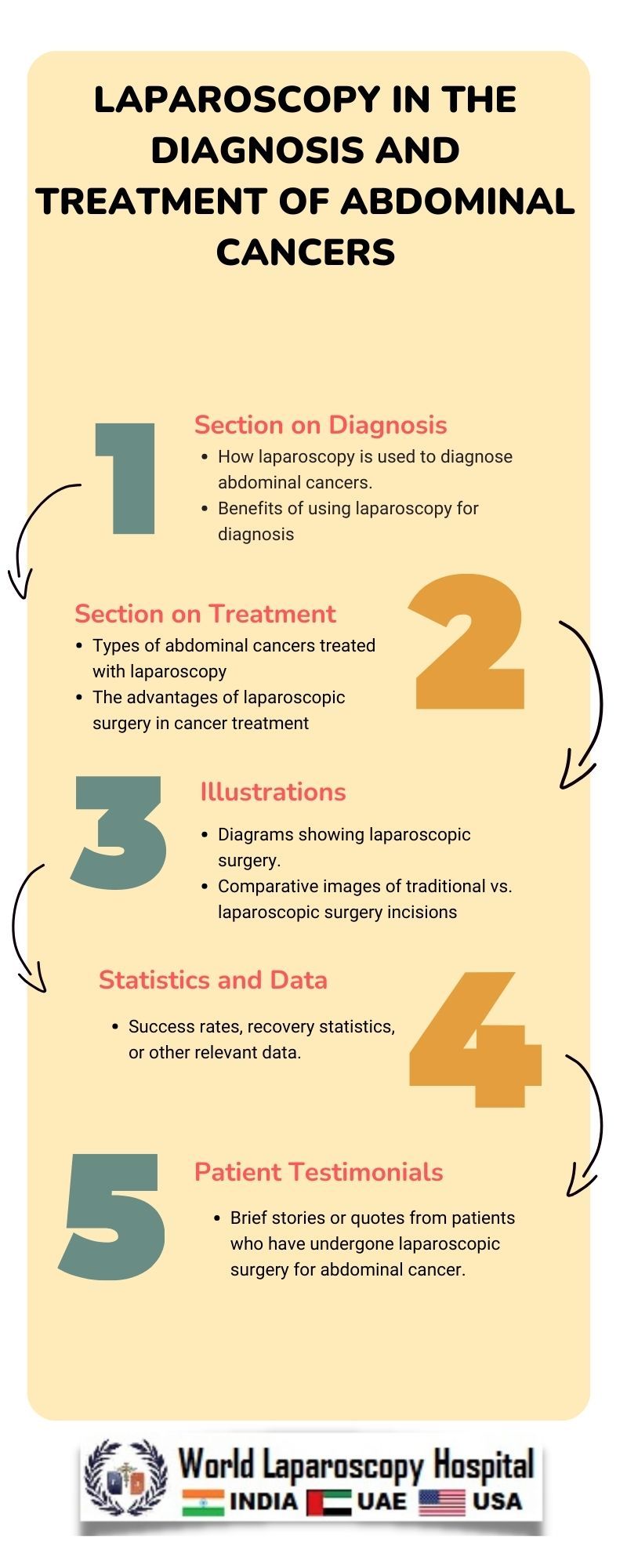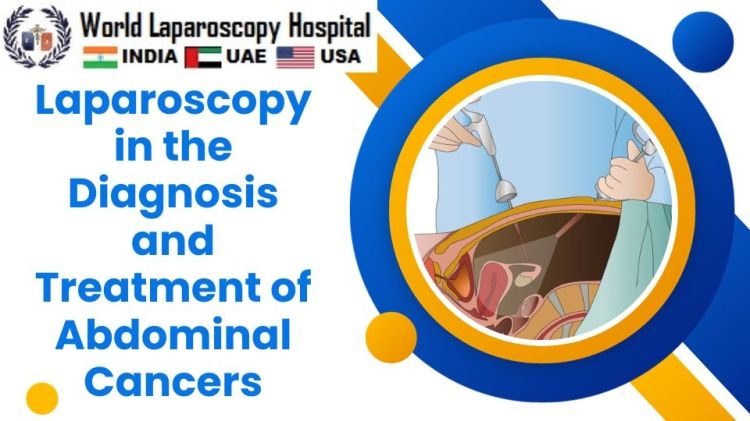Laparoscopy in the Diagnosis and Treatment of Abdominal Cancers
Laparoscopy in the Diagnosis and Treatment of Abdominal Cancers
Introduction:
Abdominal cancers pose a significant health challenge globally, requiring advanced diagnostic and treatment approaches. Laparoscopy, a minimally invasive surgical technique, has emerged as a crucial tool in the comprehensive management of abdominal cancers. This article delves into the multifaceted role of laparoscopy in the diagnosis and treatment of abdominal cancers, highlighting its advantages, applications, and future prospects.

Understanding Abdominal Cancers
Begin by providing an overview of common abdominal cancers, including colorectal cancer, pancreatic cancer, liver cancer, and gastric cancer. Discuss the challenges associated with their diagnosis and treatment, emphasizing the need for innovative approaches.
Introduction to Laparoscopy
Define laparoscopy and explain how it differs from traditional open surgery. Detail the laparoscopic procedure, involving the use of a laparoscope—a thin tube with a camera and light source—to visualize the abdominal cavity.
Diagnosing Abdominal Cancers with Laparoscopy
Explore the diagnostic applications of laparoscopy in identifying and staging abdominal cancers. Discuss how the minimally invasive nature of laparoscopy allows for a more accurate assessment of tumor size, location, and spread, aiding in treatment planning.
Laparoscopic Biopsy
Detail the process of laparoscopic biopsy, highlighting its precision in obtaining tissue samples for pathological examination. Discuss the advantages over traditional biopsy methods and how it contributes to a quicker and more accurate diagnosis.
Staging and Imaging with Laparoscopy
Explain how laparoscopy facilitates staging procedures, such as assessing lymph node involvement and detecting metastases. Explore the integration of laparoscopic imaging techniques, such as ultrasound and fluorescence imaging, to enhance diagnostic accuracy.
Laparoscopic Treatment Approaches
Discuss the various ways laparoscopy is utilized in the treatment of abdominal cancers. This may include tumor resection, organ-sparing procedures, and the use of laparoscopic-assisted techniques in combination with other treatments like chemotherapy and radiation therapy.
Tumor Resection via Laparoscopy
Examine the feasibility and outcomes of laparoscopic tumor resection for different types of abdominal cancers. Discuss studies and cases that showcase the efficacy of laparoscopy in achieving oncologically sound resections while minimizing postoperative complications.
Organ-Sparing Approaches
Explore how laparoscopy allows for organ-sparing procedures, preserving critical structures and improving patients' quality of life. Highlight specific cases where organ-sparing techniques have proven successful in treating abdominal cancers.
Combined Therapies with Laparoscopy
Discuss the role of laparoscopy in conjunction with other cancer treatments, such as chemotherapy and radiation therapy. Examine how a multidisciplinary approach improves overall outcomes and reduces the burden of treatment on patients.
Advantages of Laparoscopy in Abdominal Cancer Management
Detail the key advantages of laparoscopy in the context of abdominal cancer diagnosis and treatment. This may include reduced postoperative pain, shorter hospital stays, quicker recovery times, and improved cosmetic outcomes.
Patient Recovery and Quality of Life
Explore how the minimally invasive nature of laparoscopy positively impacts patient recovery, allowing for a faster return to daily activities and improved overall quality of life.
Reduced Surgical Complications
Discuss studies and data showcasing the lower rates of surgical complications associated with laparoscopy compared to open surgery. Highlight the potential economic benefits associated with reduced postoperative complications.
Challenges and Considerations
Acknowledge the challenges and limitations of laparoscopy in the context of abdominal cancer management. Discuss factors such as the learning curve for surgeons, cost considerations, and patient selection criteria.
Future Directions and Innovations
Explore emerging technologies and innovations in laparoscopy that hold promise for further enhancing its role in the diagnosis and treatment of abdominal cancers. This may include robotic-assisted laparoscopy, augmented reality applications, and advancements in imaging techniques.
Conclusion:
Summarize the article's key points, emphasizing the pivotal role of laparoscopy in revolutionizing the approach to abdominal cancer diagnosis and treatment. Conclude with insights into the ongoing evolution of laparoscopic techniques and their potential to shape the future of cancer care.
Top
Introduction:
Abdominal cancers pose a significant health challenge globally, requiring advanced diagnostic and treatment approaches. Laparoscopy, a minimally invasive surgical technique, has emerged as a crucial tool in the comprehensive management of abdominal cancers. This article delves into the multifaceted role of laparoscopy in the diagnosis and treatment of abdominal cancers, highlighting its advantages, applications, and future prospects.

Understanding Abdominal Cancers
Begin by providing an overview of common abdominal cancers, including colorectal cancer, pancreatic cancer, liver cancer, and gastric cancer. Discuss the challenges associated with their diagnosis and treatment, emphasizing the need for innovative approaches.
Introduction to Laparoscopy
Define laparoscopy and explain how it differs from traditional open surgery. Detail the laparoscopic procedure, involving the use of a laparoscope—a thin tube with a camera and light source—to visualize the abdominal cavity.
Diagnosing Abdominal Cancers with Laparoscopy
Explore the diagnostic applications of laparoscopy in identifying and staging abdominal cancers. Discuss how the minimally invasive nature of laparoscopy allows for a more accurate assessment of tumor size, location, and spread, aiding in treatment planning.
Laparoscopic Biopsy
Detail the process of laparoscopic biopsy, highlighting its precision in obtaining tissue samples for pathological examination. Discuss the advantages over traditional biopsy methods and how it contributes to a quicker and more accurate diagnosis.
Staging and Imaging with Laparoscopy
Explain how laparoscopy facilitates staging procedures, such as assessing lymph node involvement and detecting metastases. Explore the integration of laparoscopic imaging techniques, such as ultrasound and fluorescence imaging, to enhance diagnostic accuracy.
Laparoscopic Treatment Approaches
Discuss the various ways laparoscopy is utilized in the treatment of abdominal cancers. This may include tumor resection, organ-sparing procedures, and the use of laparoscopic-assisted techniques in combination with other treatments like chemotherapy and radiation therapy.
Tumor Resection via Laparoscopy
Examine the feasibility and outcomes of laparoscopic tumor resection for different types of abdominal cancers. Discuss studies and cases that showcase the efficacy of laparoscopy in achieving oncologically sound resections while minimizing postoperative complications.
Organ-Sparing Approaches
Explore how laparoscopy allows for organ-sparing procedures, preserving critical structures and improving patients' quality of life. Highlight specific cases where organ-sparing techniques have proven successful in treating abdominal cancers.
Combined Therapies with Laparoscopy
Discuss the role of laparoscopy in conjunction with other cancer treatments, such as chemotherapy and radiation therapy. Examine how a multidisciplinary approach improves overall outcomes and reduces the burden of treatment on patients.
Advantages of Laparoscopy in Abdominal Cancer Management
Detail the key advantages of laparoscopy in the context of abdominal cancer diagnosis and treatment. This may include reduced postoperative pain, shorter hospital stays, quicker recovery times, and improved cosmetic outcomes.
Patient Recovery and Quality of Life
Explore how the minimally invasive nature of laparoscopy positively impacts patient recovery, allowing for a faster return to daily activities and improved overall quality of life.
Reduced Surgical Complications
Discuss studies and data showcasing the lower rates of surgical complications associated with laparoscopy compared to open surgery. Highlight the potential economic benefits associated with reduced postoperative complications.
Challenges and Considerations
Acknowledge the challenges and limitations of laparoscopy in the context of abdominal cancer management. Discuss factors such as the learning curve for surgeons, cost considerations, and patient selection criteria.
Future Directions and Innovations
Explore emerging technologies and innovations in laparoscopy that hold promise for further enhancing its role in the diagnosis and treatment of abdominal cancers. This may include robotic-assisted laparoscopy, augmented reality applications, and advancements in imaging techniques.
Conclusion:
Summarize the article's key points, emphasizing the pivotal role of laparoscopy in revolutionizing the approach to abdominal cancer diagnosis and treatment. Conclude with insights into the ongoing evolution of laparoscopic techniques and their potential to shape the future of cancer care.
